Voltage control of grid - connected PV system facing voltage sags
There is an exponential growth of implementation of renewable energy generation systems in recent years.
The photovoltaic system (PV system) takes an important place due to its simple integration to the grid.
However, a disturbance in the grid could have a significant impact on PV system operation. Voltage sags are
acknowledged to be one of the major power quality disturbances which can provoke the PV system
disconnection due to the decoupling protection. With a less severe voltage sags, for example in case of a
momentary faults or short circuits on the adjacent feeder, this disconnection is not desired. This results to the
essential need of the development a voltage control at the connection point. This article presents the
development an auto adaptative voltage control integrated into the PV inverters. Facing the voltage sags, this
control system allows the voltage at the connection point greater than an admissible voltage threshold of
decoupling protection, the connection of PV system is so maintained. The models and simulations are
developed in Matlab-Simulink. The obtained results are satisfied.
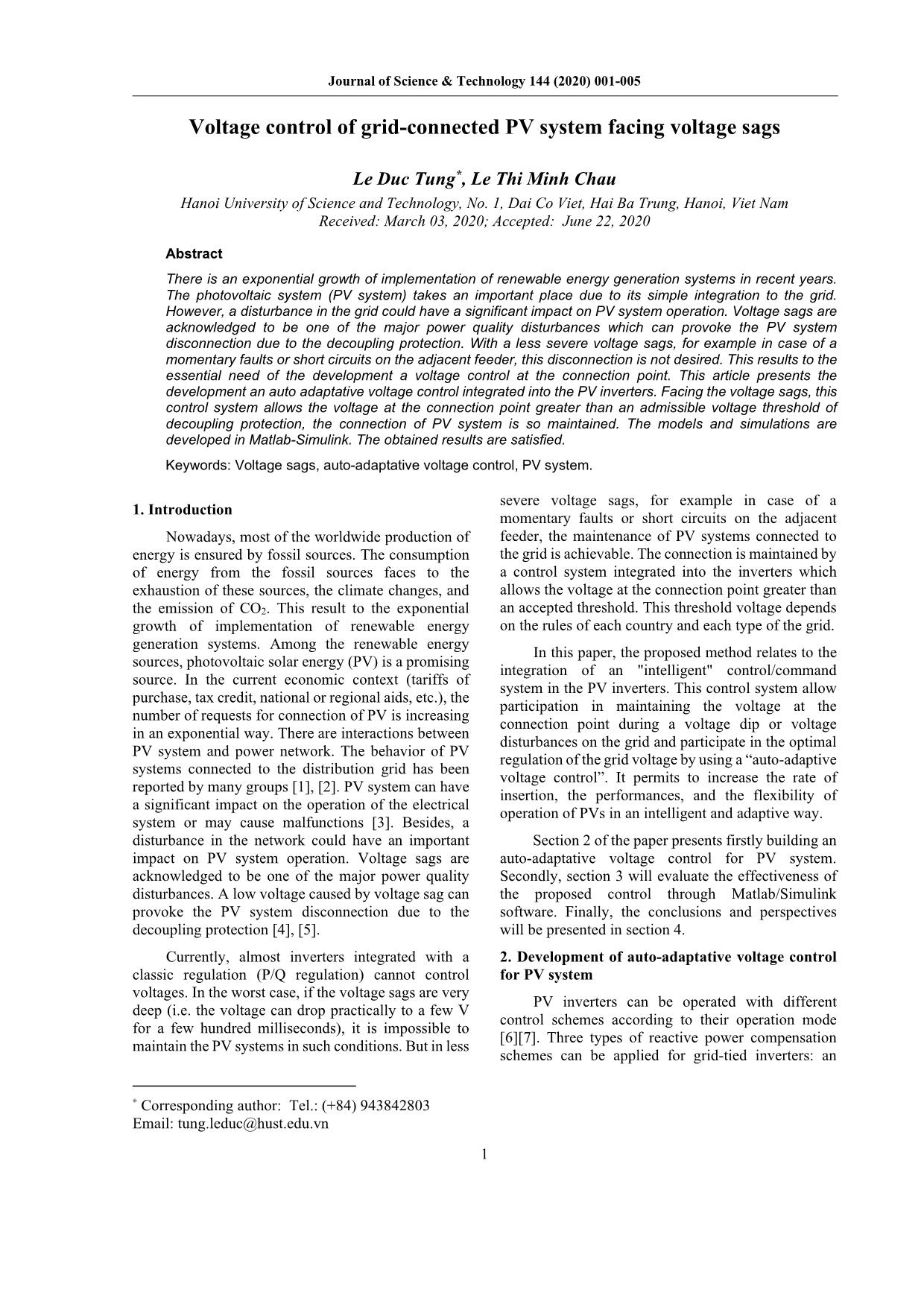
Trang 1
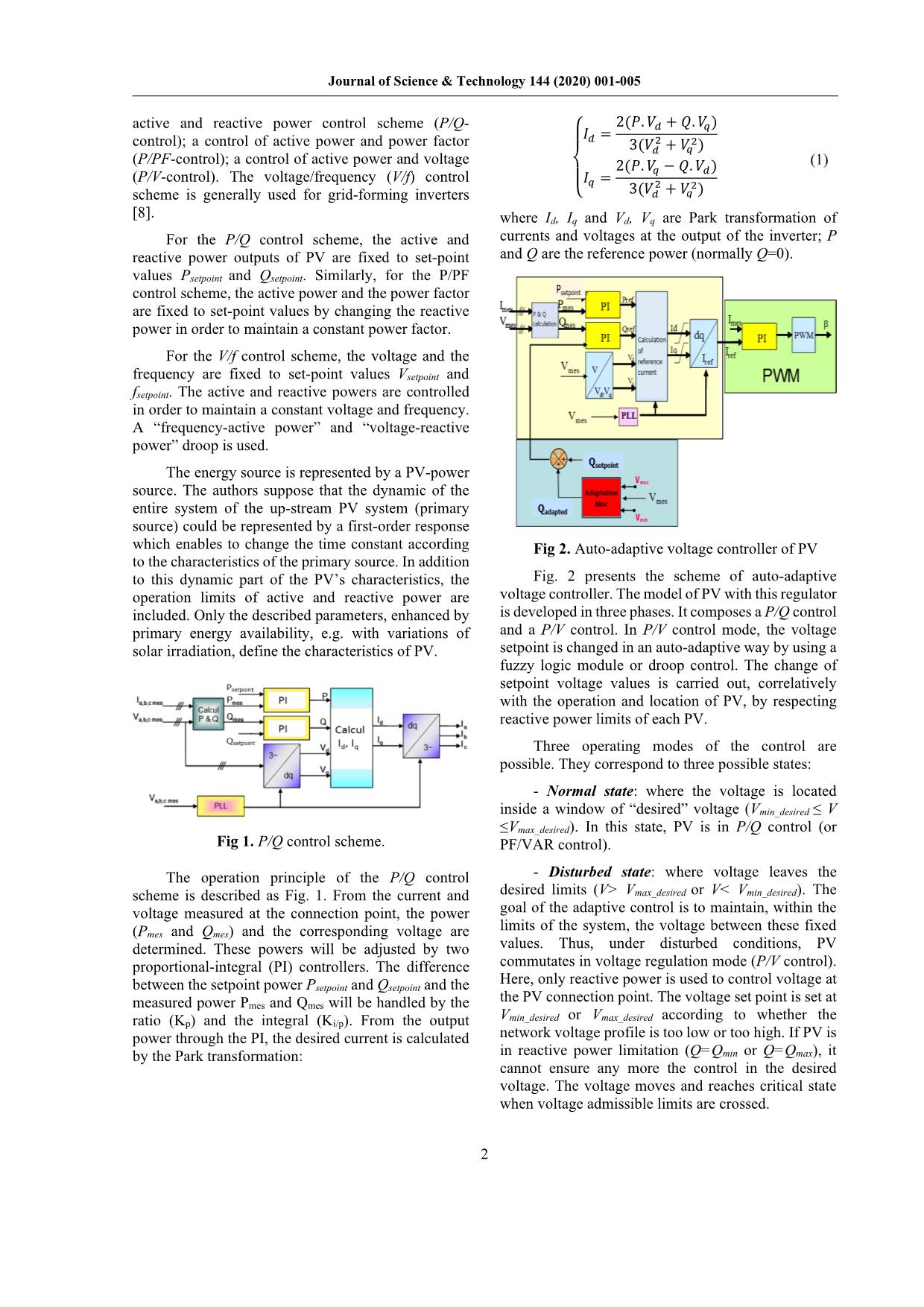
Trang 2
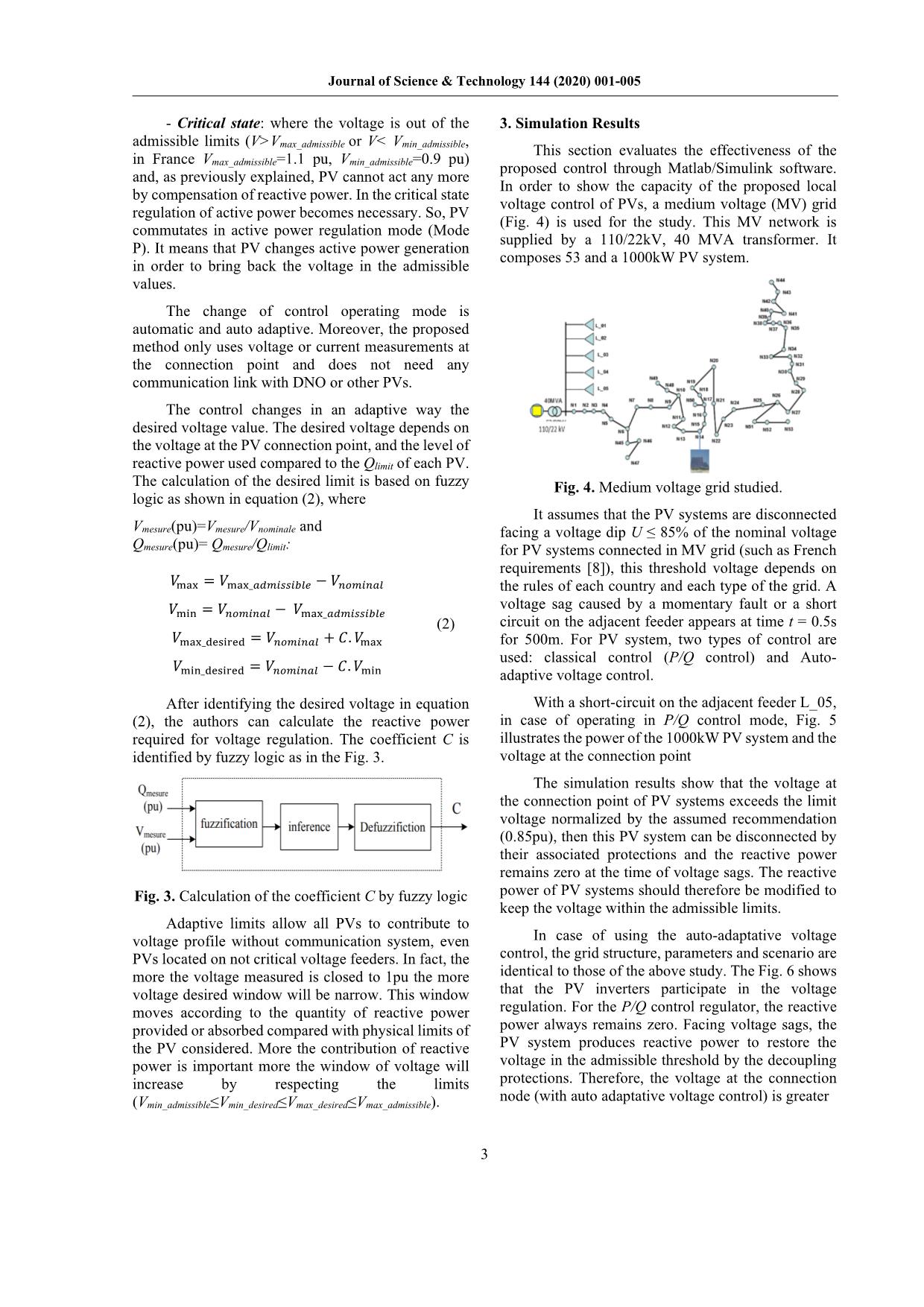
Trang 3
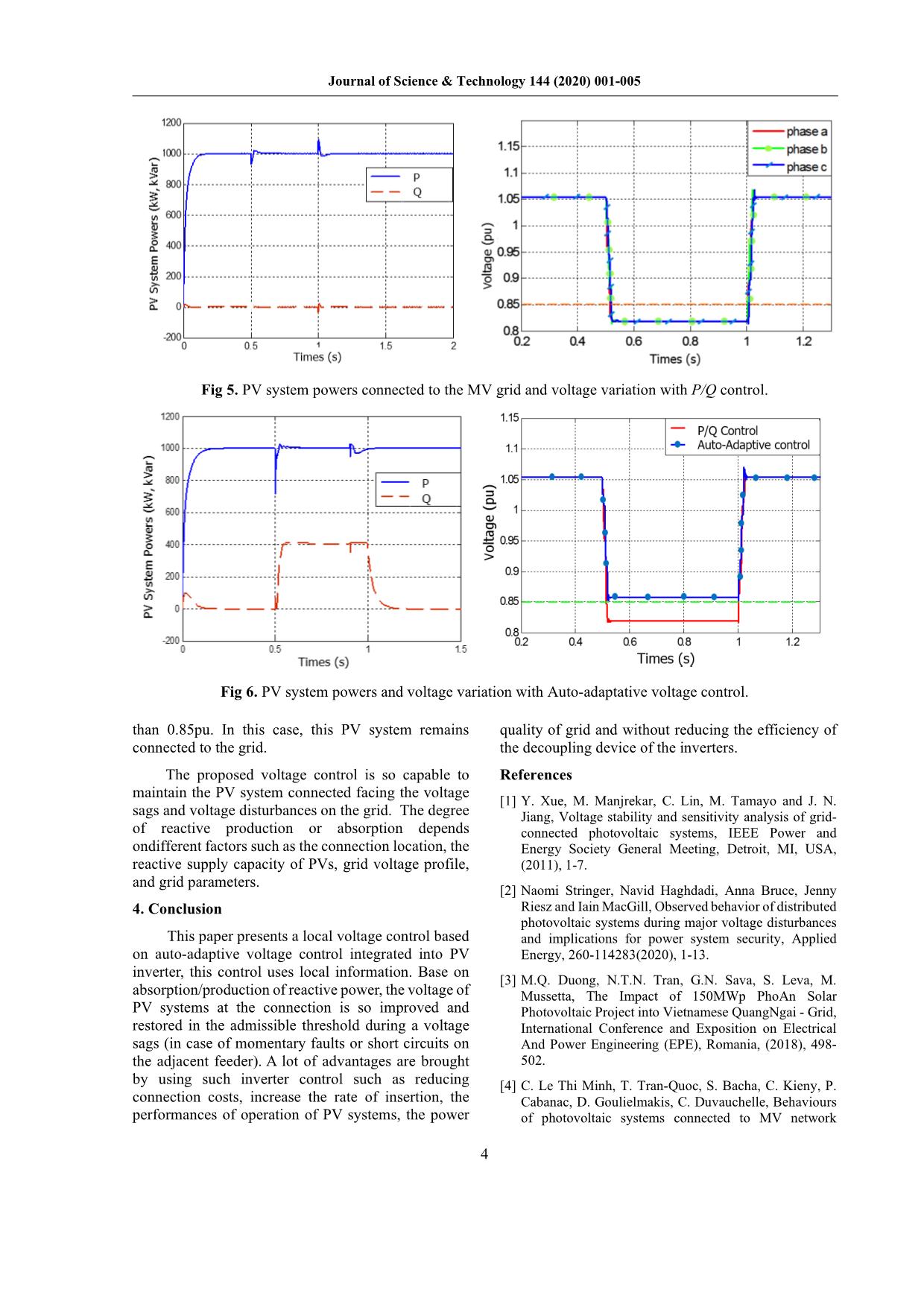
Trang 4
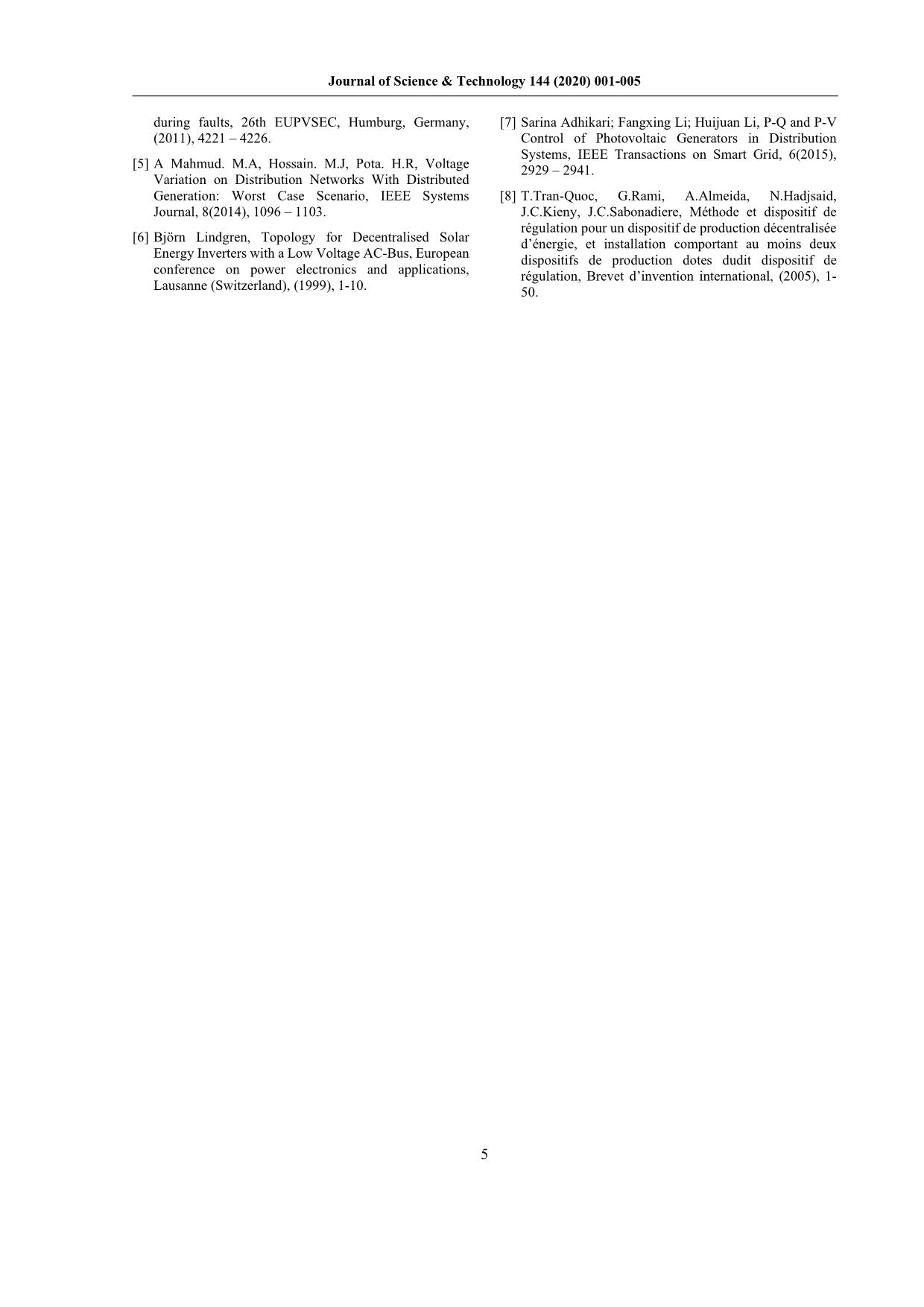
Trang 5
Tóm tắt nội dung tài liệu: Voltage control of grid - connected PV system facing voltage sags
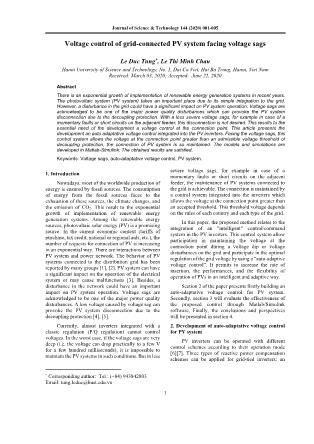
s, most of the worldwide production of energy is ensured by fossil sources. The consumption of energy from the fossil sources faces to the exhaustion of these sources, the climate changes, and the emission of CO2. This result to the exponential growth of implementation of renewable energy generation systems. Among the renewable energy sources, photovoltaic solar energy (PV) is a promising source. In the current economic context (tariffs of purchase, tax credit, national or regional aids, etc.), the number of requests for connection of PV is increasing in an exponential way. There are interactions between PV system and power network. The behavior of PV systems connected to the distribution grid has been reported by many groups [1], [2]. PV system can have a significant impact on the operation of the electrical system or may cause malfunctions [3]. Besides, a disturbance in the network could have an important impact on PV system operation. Voltage sags are acknowledged to be one of the major power quality disturbances. A low voltage caused by voltage sag can provoke the PV system disconnection due to the decoupling protection [4], [5]. Currently, almost inverters integrated with a classic regulation (P/Q regulation) cannot control voltages. In the worst case, if the voltage sags are very deep (i.e. the voltage can drop practically to a few V for a few hundred milliseconds), it is impossible to maintain the PV systems in such conditions. But in less * Corresponding author: Tel.: (+84) 943842803 Email: tung.leduc@hust.edu.vn severe voltage sags, for example in case of a momentary faults or short circuits on the adjacent feeder, the maintenance of PV systems connected to the grid is achievable. The connection is maintained by a control system integrated into the inverters which allows the voltage at the connection point greater than an accepted threshold. This threshold voltage depends on the rules of each country and each type of the grid. In this paper, the proposed method relates to the integration of an "intelligent" control/command system in the PV inverters. This control system allow participation in maintaining the voltage at the connection point during a voltage dip or voltage disturbances on the grid and participate in the optimal regulation of the grid voltage by using a “auto-adaptive voltage control”. It permits to increase the rate of insertion, the performances, and the flexibility of operation of PVs in an intelligent and adaptive way. Section 2 of the paper presents firstly building an auto-adaptative voltage control for PV system. Secondly, section 3 will evaluate the effectiveness of the proposed control through Matlab/Simulink software. Finally, the conclusions and perspectives will be presented in section 4. 2. Development of auto-adaptative voltage control for PV system PV inverters can be operated with different control schemes according to their operation mode [6][7]. Three types of reactive power compensation schemes can be applied for grid-tied inverters: an Journal of Science & Technology 144 (2020) 001-005 2 active and reactive power control scheme (P/Q- control); a control of active power and power factor (P/PF-control); a control of active power and voltage (P/V-control). The voltage/frequency (V/f) control scheme is generally used for grid-forming inverters [8]. For the P/Q control scheme, the active and reactive power outputs of PV are fixed to set-point values Psetpoint and Qsetpoint. Similarly, for the P/PF control scheme, the active power and the power factor are fixed to set-point values by changing the reactive power in order to maintain a constant power factor. For the V/f control scheme, the voltage and the frequency are fixed to set-point values Vsetpoint and fsetpoint. The active and reactive powers are controlled in order to maintain a constant voltage and frequency. A “frequency-active power” and “voltage-reactive power” droop is used. The energy source is represented by a PV-power source. The authors suppose that the dynamic of the entire system of the up-stream PV system (primary source) could be represented by a first-order response which enables to change the time constant according to the characteristics of the primary source. In addition to this dynamic part of the PV’s characteristics, the operation limits of active and reactive power are included. Only the described parameters, enhanced by primary energy availability, e.g. with variations of solar irradiation, define the characteristics of PV. Fig 1. P/Q control scheme. The operation principle of the P/Q control scheme is described as Fig. 1. From the current and voltage measured at the connection point, the power (Pmes and Qmes) and the corresponding voltage are determined. These powers will be adjusted by two proportional-integral (PI) controllers. The difference between the setpoint power Psetpoint and Qsetpoint and the measured power Pmes and Qmes will be handled by the ratio (Kp) and the integral (Ki/p). From the output power through the PI, the desired current is calculated by the Park transformation: ⎩ ⎪ ⎨ ⎪ ⎧𝐼𝐼𝑑𝑑 = 2(𝑃𝑃.𝑉𝑉𝑑𝑑 + 𝑄𝑄.𝑉𝑉𝑞𝑞)3(𝑉𝑉𝑑𝑑2 + 𝑉𝑉𝑞𝑞2) 𝐼𝐼𝑞𝑞 = 2(𝑃𝑃.𝑉𝑉𝑞𝑞 − 𝑄𝑄.𝑉𝑉𝑑𝑑)3(𝑉𝑉𝑑𝑑2 + 𝑉𝑉𝑞𝑞2) (1) where Id, Iq and Vd, Vq are Park transformation of currents and voltages at the output of the inverter; P and Q are the reference power (normally Q=0). Fig 2. Auto-adaptive voltage controller of PV Fig. 2 presents the scheme of auto-adaptive voltage controller. The model of PV with this regulator is developed in three phases. It composes a P/Q control and a P/V control. In P/V control mode, the voltage setpoint is changed in an auto-adaptive way by using a fuzzy logic module or droop control. The change of setpoint voltage values is carried out, correlatively with the operation and location of PV, by respecting reactive power limits of each PV. Three operating modes of the control are possible. They correspond to three possible states: - Normal state: where the voltage is located inside a window of “desired” voltage (Vmin_desired ≤ V ≤Vmax_desired). In this state, PV is in P/Q control (or PF/VAR control). - Disturbed state: where voltage leaves the desired limits (V> Vmax_desired or V< Vmin_desired). The goal of the adaptive control is to maintain, within the limits of the system, the voltage between these fixed values. Thus, under disturbed conditions, PV commutates in voltage regulation mode (P/V control). Here, only reactive power is used to control voltage at the PV connection point. The voltage set point is set at Vmin_desired or Vmax_desired according to whether the network voltage profile is too low or too high. If PV is in reactive power limitation (Q=Qmin or Q=Qmax), it cannot ensure any more the control in the desired voltage. The voltage moves and reaches critical state when voltage admissible limits are crossed. Journal of Science & Technology 144 (2020) 001-005 3 - Critical state: where the voltage is out of the admissible limits (V>Vmax_admissible or V< Vmin_admissible, in France Vmax_admissible=1.1 pu, Vmin_admissible=0.9 pu) and, as previously explained, PV cannot act any more by compensation of reactive power. In the critical state regulation of active power becomes necessary. So, PV commutates in active power regulation mode (Mode P). It means that PV changes active power generation in order to bring back the voltage in the admissible values. The change of control operating mode is automatic and auto adaptive. Moreover, the proposed method only uses voltage or current measurements at the connection point and does not need any communication link with DNO or other PVs. The control changes in an adaptive way the desired voltage value. The desired voltage depends on the voltage at the PV connection point, and the level of reactive power used compared to the Qlimit of each PV. The calculation of the desired limit is based on fuzzy logic as shown in equation (2), where Vmesure(pu)=Vmesure/Vnominale and Qmesure(pu)= Qmesure/Qlimit: 𝑉𝑉max = 𝑉𝑉max_𝑎𝑎𝑑𝑑𝑎𝑎𝑎𝑎𝑎𝑎𝑎𝑎𝑎𝑎𝑎𝑎𝑎𝑎𝑎𝑎 − 𝑉𝑉𝑛𝑛𝑛𝑛𝑎𝑎𝑎𝑎𝑛𝑛𝑎𝑎𝑎𝑎 𝑉𝑉min = 𝑉𝑉𝑛𝑛𝑛𝑛𝑎𝑎𝑎𝑎𝑛𝑛𝑎𝑎𝑎𝑎 − 𝑉𝑉max_𝑎𝑎𝑑𝑑𝑎𝑎𝑎𝑎𝑎𝑎𝑎𝑎𝑎𝑎𝑎𝑎𝑎𝑎𝑎𝑎 𝑉𝑉max_desired = 𝑉𝑉𝑛𝑛𝑛𝑛𝑎𝑎𝑎𝑎𝑛𝑛𝑎𝑎𝑎𝑎 + 𝐶𝐶.𝑉𝑉max 𝑉𝑉min_desired = 𝑉𝑉𝑛𝑛𝑛𝑛𝑎𝑎𝑎𝑎𝑛𝑛𝑎𝑎𝑎𝑎 − 𝐶𝐶.𝑉𝑉min (2) After identifying the desired voltage in equation (2), the authors can calculate the reactive power required for voltage regulation. The coefficient C is identified by fuzzy logic as in the Fig. 3. Fig. 3. Calculation of the coefficient C by fuzzy logic Adaptive limits allow all PVs to contribute to voltage profile without communication system, even PVs located on not critical voltage feeders. In fact, the more the voltage measured is closed to 1pu the more voltage desired window will be narrow. This window moves according to the quantity of reactive power provided or absorbed compared with physical limits of the PV considered. More the contribution of reactive power is important more the window of voltage will increase by respecting the limits (Vmin_admissible≤Vmin_desired≤Vmax_desired≤Vmax_admissible). 3. Simulation Results This section evaluates the effectiveness of the proposed control through Matlab/Simulink software. In order to show the capacity of the proposed local voltage control of PVs, a medium voltage (MV) grid (Fig. 4) is used for the study. This MV network is supplied by a 110/22kV, 40 MVA transformer. It composes 53 and a 1000kW PV system. Fig. 4. Medium voltage grid studied. It assumes that the PV systems are disconnected facing a voltage dip U ≤ 85% of the nominal voltage for PV systems connected in MV grid (such as French requirements [8]), this threshold voltage depends on the rules of each country and each type of the grid. A voltage sag caused by a momentary fault or a short circuit on the adjacent feeder appears at time t = 0.5s for 500m. For PV system, two types of control are used: classical control (P/Q control) and Auto- adaptive voltage control. With a short-circuit on the adjacent feeder L_05, in case of operating in P/Q control mode, Fig. 5 illustrates the power of the 1000kW PV system and the voltage at the connection point The simulation results show that the voltage at the connection point of PV systems exceeds the limit voltage normalized by the assumed recommendation (0.85pu), then this PV system can be disconnected by their associated protections and the reactive power remains zero at the time of voltage sags. The reactive power of PV systems should therefore be modified to keep the voltage within the admissible limits. In case of using the auto-adaptative voltage control, the grid structure, parameters and scenario are identical to those of the above study. The Fig. 6 shows that the PV inverters participate in the voltage regulation. For the P/Q control regulator, the reactive power always remains zero. Facing voltage sags, the PV system produces reactive power to restore the voltage in the admissible threshold by the decoupling protections. Therefore, the voltage at the connection node (with auto adaptative voltage control) is greater Journal of Science & Technology 144 (2020) 001-005 4 Fig 5. PV system powers connected to the MV grid and voltage variation with P/Q control. Fig 6. PV system powers and voltage variation with Auto-adaptative voltage control. than 0.85pu. In this case, this PV system remains connected to the grid. The proposed voltage control is so capable to maintain the PV system connected facing the voltage sags and voltage disturbances on the grid. The degree of reactive production or absorption depends ondifferent factors such as the connection location, the reactive supply capacity of PVs, grid voltage profile, and grid parameters. 4. Conclusion This paper presents a local voltage control based on auto-adaptive voltage control integrated into PV inverter, this control uses local information. Base on absorption/production of reactive power, the voltage of PV systems at the connection is so improved and restored in the admissible threshold during a voltage sags (in case of momentary faults or short circuits on the adjacent feeder). A lot of advantages are brought by using such inverter control such as reducing connection costs, increase the rate of insertion, the performances of operation of PV systems, the power quality of grid and without reducing the efficiency of the decoupling device of the inverters. References [1] Y. Xue, M. Manjrekar, C. Lin, M. Tamayo and J. N. Jiang, Voltage stability and sensitivity analysis of grid- connected photovoltaic systems, IEEE Power and Energy Society General Meeting, Detroit, MI, USA, (2011), 1-7. [2] Naomi Stringer, Navid Haghdadi, Anna Bruce, Jenny Riesz and Iain MacGill, Observed behavior of distributed photovoltaic systems during major voltage disturbances and implications for power system security, Applied Energy, 260-114283(2020), 1-13. [3] M.Q. Duong, N.T.N. Tran, G.N. Sava, S. Leva, M. Mussetta, The Impact of 150MWp PhoAn Solar Photovoltaic Project into Vietnamese QuangNgai - Grid, International Conference and Exposition on Electrical And Power Engineering (EPE), Romania, (2018), 498- 502. [4] C. Le Thi Minh, T. Tran-Quoc, S. Bacha, C. Kieny, P. Cabanac, D. Goulielmakis, C. Duvauchelle, Behaviours of photovoltaic systems connected to MV network Journal of Science & Technology 144 (2020) 001-005 5 during faults, 26th EUPVSEC, Humburg, Germany, (2011), 4221 – 4226. [5] A Mahmud. M.A, Hossain. M.J, Pota. H.R, Voltage Variation on Distribution Networks With Distributed Generation: Worst Case Scenario, IEEE Systems Journal, 8(2014), 1096 – 1103. [6] Björn Lindgren, Topology for Decentralised Solar Energy Inverters with a Low Voltage AC-Bus, European conference on power electronics and applications, Lausanne (Switzerland), (1999), 1-10. [7] Sarina Adhikari; Fangxing Li; Huijuan Li, P-Q and P-V Control of Photovoltaic Generators in Distribution Systems, IEEE Transactions on Smart Grid, 6(2015), 2929 – 2941. [8] T.Tran-Quoc, G.Rami, A.Almeida, N.Hadjsaid, J.C.Kieny, J.C.Sabonadiere, Méthode et dispositif de régulation pour un dispositif de production décentralisée d’énergie, et installation comportant au moins deux dispositifs de production dotes dudit dispositif de régulation, Brevet d’invention international, (2005), 1- 50.
File đính kèm:
 voltage_control_of_grid_connected_pv_system_facing_voltage_s.pdf
voltage_control_of_grid_connected_pv_system_facing_voltage_s.pdf

